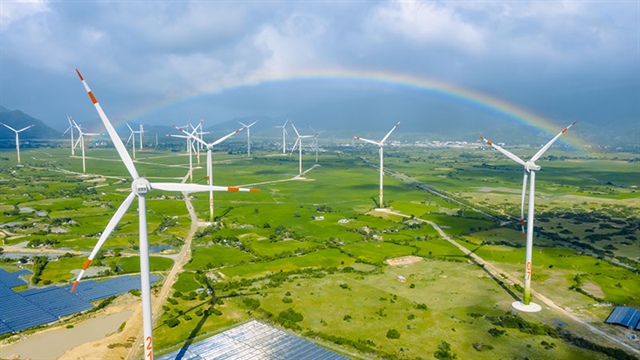Vietnam to extend current wind power feed-in tariff to March 2022
Vietnam to extend current wind power feed-in tariff to March 2022
The extension, for at least three to six months, has been proposed by both domestic and foreign experts to tackle problems caused to investors over Covid impact.
Vietnam will extend the current feed-in tariff (FiT) for wind power projects to March 31, 2022, five months more than the original schedule, to support investors who suffered the delay due to Covid-19.

A wind farm developed by Vietnam's Trungnam Group in Ninh Thuan. Photo: Trung Nam Group |
“The extension of the current wind power FiT can be one of the solutions in the economic recovery plan. It is necessary to put it in such a context to tackle problems facing businesses,” Vuong Dinh Hue, chairman of the National Assembly (NA), the highest legislative body, said at a meeting on November 6 with authorities in Ninh Thuan, the wind and solar hub of Vietnam.
Under the government’s Decision No.39 dated in September 2018, FiT for onshore wind power is 8.5 US cents and 9.8 US cents for wind power projects which partly or wholly came into operation prior to November 1, 2021. The tariff will be applied for 20 years since the commercial operations.
Covid impact and concerns
Covid-19 ravaged Vietnam in the fresh outbreak that flared up in late April. The months-long widespread transmission has put brakes on the production and construction of wind projects in particular.
Concerning the impact caused by Covid-19, the Ministry of Industry and Trade (MoIT) over the past time has received various suggestions on the extension of the current wind power FiT. “It prompted us to submit solutions for the ongoing projects,” according to Hoang Tien Dung, head of the MoIT’s Electricity and Renewable Energy Authority (EREA).
He said that the MoIT has built different plans on calculating the prices of wind power to comply with Law on Investment, Law on Bidding, Law on Price, Law on Electricity with the possibility of bidding.
It means that wind power may move to an auction-based competitive bidding system to replace FiT.

Vu Chi Mai, team leader of the Renewable Energy component under the Renewable Energy and Energy Efficiency (4E) project of the GIZ Energy Support Programme (ESP). |
Commenting on the Covid-19 impact, Vu Chi Mai, team leader of the Renewable Energy component under the Renewable Energy and Energy Efficiency (4E) project of the GIZ Energy Support Programme (ESP), said that the pandemic which ravaged southern Vietnam between May and September has left investors in a tough time.
Unfortunately, places that seriously suffered from the pandemic are renewable hubs, home to dozens of wind farms. The pandemic evolution has slowed the projects’ construction progress, delaying the plans to connect to the power grid, Mai told The Hanoi Times.
She admitted that Covid-19 is an objective factor that the policy tool under Decision 39 has not taken into account, affecting wind power projects (onshore, nearshore, offshore).
For that reason, German and Danish representatives in Vietnam have suggested that more time should be given to projects that had taken certain steps in the investment process but were delayed due to Covid-19 like transporting turbines and the mobility of foreign experts. The extension can be three to six months.
It’s necessary to have concrete support from the government and extending the application of FiTs is one of the best support, Mai said, adding that the FiT plays an important role in navigating the market prices for wind power and is a crucial factor for investors to keep running their projects.
In a broader move, the tariff enables them to pursue their investment portfolios. In other words, it helps maintain the appetite for Vietnam’s wind power market.
Meanwhile, Henri Wasnick, Senior Advisor of the Renewable Energy Center, Institute of Energy under MoIT, said the FiT is the foundation for wind power projects in the first phase of technology introduction to encourage investment in the energy sector. After the market has developed under fixed FiT conditions, however, more efficient mechanisms should be considered in the long term, for example, the direct power purchase agreement (DPPA) and auction. In order to maintain the long-term trust of international investors and financiers, a Covid-19 related extension of the FiT is highly recommended.
Experiences from other countries show important lessons for Vietnam and DPPA with its advantages would be a good choice to accelerate the global trend of international industrial affiliation through the award of green certificates and to achieve efficient prices, Henri Wasnick told The Hanoi Times.

Henri Wasnick, Senior Advisor of the Renewable Energy Center, Institute of Energy under MoIT. |
As Covid-19 attacked many parts of Vietnam in May-September, the Global Wind Energy Council (GWEC) has expressed concerns that the pandemic restrictions caused significant delays for wind project construction in the context that they were rushing to complete ahead of the expiry of the FiT in late October.
Without a Covid-19 relief measure to extend the FiT for wind projects by at least six months, these projects will become collateral damage of the pandemic and almost 21,000 potential jobs at risk, GWEC said in a request released on September 9.
This will translate into lost investment and tax revenue for local governments, delayed progress towards Vietnam’s renewable energy aims in Resolution 55, and a “bust” cycle in Vietnam’s wind market which may take years to recover, it stressed.
The covid-caused impact will likely leave US$6.7 billion investment in 4,000 MW wind power projects in Vietnam at risk, it stated.
Ben Backwell, CEO of GWEC said pandemic-related disruptions to travel, worker mobility and supply chains have reverberated across different countries over the last 1.5 years, requiring many countries like the US, UK, Germany, India, and Greece to implement Covid relief packages or deadline extensions for projects to reach their commissioning date.
Vietnam needs to take similar relief measures to support the nascent onshore wind industry which has been heavily impacted by Covid-19, he noted.
Given the deadline by October 31, 2021, investors rushed to run for the time limit. According to Vietnam Electricity (EVN), more than half (69 plants with a total capacity of 3,298 MW) of 106 wind power projects have been officially recognized for commercial operation (COD) since October 2021, and are eligible for the FiT according to the regulations of the Government of Vietnam.

Minister of Industry and Trade Nguyen Hong Dien at a parliament's interpolation on Nov 9. Photo: Hoang Phong |
State’s perspective
Concerning the extension of FiT, MoIT Minister Nguyen Hong Dien on November 9 said at the ongoing National Assembly’s sitting that the extension, if prolong, is unreasonable as it will not be true to the limited nature of the support policy, causing inequality with other projects under the same mechanism but have been implemented on schedule.
Meanwhile, the input prices of materials and equipment in wind power are now lower than at the time of issuing the supporting policies and continue the downward trend. If this policy persists, there may cause legal consequences, causing economic losses. In addition, the MoIT did not receive an agreement from relevant agencies on the issue.
“The MoIT shares difficulties with investors and localities where wind power projects are behind schedules. However, the FIT is a support price mechanism applied only in a certain period of time to encourage investments in some needed fields. For that reason, it is not reasonable to maintain it for a long time,” Dien said in a statement.
He noted that the ministry is building a plan on developing wind and solar power projects under the public-private partnership (PPP) with a focus on bidding and auction mechanism to select investors and determine electricity prices.
Accordingly, investors will negotiate with Vietnam Electricity (EVN) on the electricity prices within the rates issued by MoIT. Unfinished projects will be solved based on the ministry’s regulations.
























